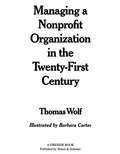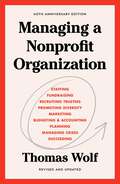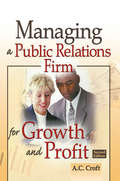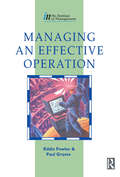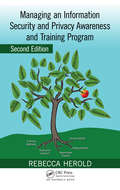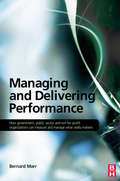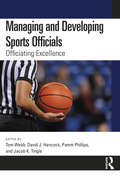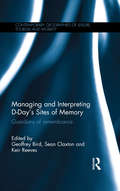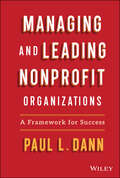- Table View
- List View
Managing a Global Team: Greg James at Sun Microsystems, Inc. (A)
by Tsedal Neeley Thomas J. DeLongGreg James, a global manager at Sun Microsystems, Inc., sets out to meet with his entire 43-member customer implementation team spread across India, France, the United Arab Emirates, and the United States of America to resolve a dire customer system outage as required by a service agreement. Rather than finding a swift resolution to the rapidly escalating customer situation that motivated his trip, he finds himself facing distributed work, global collaboration, conflict and management issues that are threatening to unravel his team.
Managing a Global Team: Greg James at Sun Microsystems, Inc. (A)
by Thomas J. Delong Tsedal NeeleyGreg James, a global manager at Sun Microsystems, Inc., sets out to meet with his entire 43-member customer implementation team spread across India, France, the United Arab Emirates, and the United States of America to resolve a dire customer system outage as required by a service agreement. Rather than finding a swift resolution to the rapidly escalating customer situation that motivated his trip, he finds himself facing distributed work, global collaboration, conflict and management issues that are threatening to unravel his team.
Managing a Global Team: Greg James at Sun Microsystems, Inc. (B)
by Tsedal NeeleyThis case updates students on the steps Greg James took to solve the problems that instigated the crisis documented in "Managing a Global Team: Greg James at Sun Microsystems, Inc. (A)." We find out how James solves the process problems involved in his team's breakdown and creates team cohesion to help them function together effectively. We also learn whether or not James is successful in taking his global team to a new level of productivity and customer service.
Managing a Global Workforce
by Yongsun Paik Charles M. VanceThis new edition of Managing a Global Workforce provides balanced and contemporary coverage of human resource management in the international marketplace. Directed at future general managers and international executives, rather than HR specialists, it is designed to help students as well as professionals recognize the critical human resource issues underlying the cultural and economic challenges they face.
Managing a Global Workforce: Challenges And Opportunities In International Human Resources Management
by Yongsun Paik Fabian Jintae Froese Charles Vance Torben AndersenManaging a Global Workforce examines important human resource management issues and practices in today’s global marketplace, helping current and future managers and leaders, regardless of nationality, in making effective human talent management decisions for optimal organizational performance. This fourth edition includes significant updates to reflect recent global developments affecting the management of global HRM, including the following: • The COVID-19 pandemic and its impact on new work expectations/arrangements; • The Great Resignation; • AI and automation; • Managing diversity, equity, and inclusion; • Climate change; • Emerging economies; and • CSR/ethics/sustainability The new edition also includes several new opening and closing brief cases to promote applied reflection and discussion, as well as updated references to important research. With its practical, real-world emphasis, including frequent use of current examples, the text also serves as a useful resource for guiding the global workforce management and decision-making of current and future general managers and human resource practitioners. This book is essential reading for general graduate and undergraduate business students, as well as those in specialty programs in International Business and Human Resources.
Managing a Hospital: How to Succeed as a Clinical Leader in the Post-Pandemic Age (Business Guides on the Go)
by Otto Armin SmisethThis book demonstrates how hospitals can be transformed into dynamic, patient-centered, and cost-effective organizations. It describes systems for providing safe, high-quality medical services and outlines the importance of data for health outcomes. In this regard, the book underscores the importance of decision-making and delegation, as well as the effective use of administrative staff, new technologies, and evidence-based medicine to benefit patients and boost efficiency. At the same time, it emphasizes the importance of applying metrics to improve cost-effectiveness. Although primarily intended as a hands-on book for clinical leaders, it also considers hospitals from a broader societal perspective, making it of interest to leaders at all organizational levels in hospitals and to policymakers alike.
Managing a Nonprofit Organization in the Twenty-First Century
by Thomas WolfSince this classic work was originally published in 1984, there have been major shifts in the nonprofit world -- the growth of more profit-oriented ventures, the overhaul of accounting rules, new partnerships, and an emphasis on customer-oriented service and leadership. In easy-to-understand language, Thomas Wolf explains how to cope with these changes and deal with the traditional challenges of managing staff, trustees, and volunteers.
Managing a Nonprofit Organization: 40th Anniversary Revised and Updated Edition
by Thomas WolfMANAGING A NONPROFIT ORGANIZATION has been an essential resource for nonprofit administrators, managers, and business professors since 1984. It is a classic in its field. But much has changed since it was last updated in 1999, as the United States reels from political, economic, and demographic shifts, all of which impact nonprofit organizations every day. In the current economy, nonprofits are trying to make ends meet. They are responding to technological innovation in the age of social media and viral marketing. Nonprofit administrators, trustees, and volunteers need Thomas Wolf's solid advice now more than ever. So do the many college and university students preparing for work in the nonprofit arena. Dr. Wolf's update of Managing a Nonprofit Organization includes material that tackles the demands and challenges faced by nonprofit managers as a result of the legislative and policy changes enacted after 9/11 and in the wake of the economic collapse of 2008. Highlighting the generational issues facing many nonprofits, as current management ages and a younger generation prepares to take the reins, Dr. Wolf suggests ways for organizations to best manage these transitions and adapt to a rapidly changing world. In easy-to-understand language and with study questions at the end of each chapter, Dr. Wolf explains how to cope with all the changes, giving you everything you need to know to be a highly successful nonprofit leader.
Managing a Public Image: Cheri Mack
by Robin J. Ely Ingrid VargasCheri Mack, an African-American woman, has just arrived at Harvard Business School after working for three years at a major consulting firm where she learned to adopt the demeanor of her male colleagues in order to fit in. Some of her male classmates are critical of her masculine, aggressive style in the classroom. As she begins to plan for a new career in health care, their criticisms cause her to wonder whether having shed much of her femininity will compromise her effectiveness as a leader.
Managing a Public Image: Kevin Knight
by Robin J. Ely Ingrid VargasKevin Knight recounts an uncomfortable situation he faced as an African-American student at Harvard Business School. Concerned with maintaining an image as a calm and rational person, he is appalled when he finds himself in a heated classroom exchange in defense of an African-American case protagonist. Knight questions whether his fears about ethnic stereotypes had prevented him from learning important leadership skills. Knight reflects on his image concerns, questioning whether they have undermined his ability to lead effectively.
Managing a Public Image: Rob Thomas
by Robin J. Ely Ingrid VargasRob Thomas describes some of the challenges he has faced as a white, middle-aged man who is managing director of a mid-size consulting firm where he is committed to increasing staff gender and racial diversity. Unwilling to risk the disapproval of any constituency, Thomas was initially paralyzed by his desire to appear as a fair and infallible leader. When a capable but undistinguished female consultant comes up for partner, Thomas decides to take a stand, but his efforts to get her promoted fail. In the end, Thomas questions whether he has been an effective leader in support of a cause about which he cares deeply. Thomas reflects on his image concerns, questioning whether they have undermined his ability to exercise leadership effectively.
Managing a Public Image: Sophie Chen
by Robin J. Ely Ingrid VargasSophie Chen, an Asian-American MBA student at Harvard Business School, describes a professional situation in which she was unable to mentor a junior person effectively because she disapproved of the way her Asian-American mentee conformed to an ethnic stereotype. Feeling the need to distance herself from the stereotype, Chen concluded that there was little she could do to help her mentee. By the end of her narrative, Chen questions whether she could have been a more effective mentor. She reflects on her image concerns, questioning whether they have undermined her ability to exercise leadership effectively.
Managing a Public Relations Firm for Growth and Profit
by Alvin C CroftThe one-of-a-kind how-to book that puts effective agency management strategies at your fingertipsThe classic text that describes in detail how to successfully manage and market a public relations firm, has been completely updated with three new chapters and is now more than 50% longer. This one-of-a-kind new edition is bursting with creative tips, instructions, philosophies, theories, and guidance, all to help you steer your firm to success. It demonstrates how to market, promote, and sell a firm to attract, win, and hold the right clientele. You will learn how to manage a new or existing firm so that it is productive and profitable and has a long-range future. Information in Managing a Public Relations Firm for Growth and Profit, Second Edition is based on author A. C. Croft&’s extensive experience in the field-almost twenty years as a consultant to PR firm principals and more than 25 years as an employee or principal of three medium-sized successful PR agencies. Croft begins each chapter with a brief profile of a seasoned and successful PR firm principal from a mid-sized firm. These professionals tell of their successes and also relate early mistakes that you would do well to avoid. The text includes tables and figures to make data easily understood.The extensively revised Managing a Public Relations Firm for Growth and Profit, Second Edition discusses pertinent topics such as: keys to new business success developing a marketing plan serving clients communication to prospects management strategies for success installing efficient systems and procedures managing staff productivity forecasting income management systems and procedures managing profitability client and agency budgeting recruiting, training, and retaining staff crisis planning planning the future of your firmCovering everything from billing practices and self-promotion to the use of computers and student interns, Managing a Public Relations Firm for Growth and Profit, Second Edition is one guide you are sure to refer to again and again for practical advice. It is must reading for owners of small- and medium-sized PR firms; senior managers of small, medium, and national firms who wish to expand their management knowledge and ability or who are considering starting their own firm; lower-level staff members who want to increase their knowledge of agency management; and university public relations professors who would like to include a primer on PR firm management in their classes.
Managing a Task Force
by James P. WareDescribes several principles for improving the effectiveness of internal task forces. Suggests a number of guidelines for starting up a task force, conducting the first meeting, managing the group's activities, and completing the project.
Managing a Transport Business: Business Management in Transport 2 (Routledge Library Editions: Transport Economics #14)
by W.S. BarryThis book, first published in 1963, uses the framework of the author’s Fundamentals of Management for studying the management of transport undertakings.
Managing an Age Diverse Workforce
by Emma Parry Shaun Tyson.Unique in the multiple approaches that it encompasses, this book includes discussions of both older and younger workers, employer and employee perspectives, generational and age diversity and international comparisons. It includes both conceptual argument and empirical research in order to provide insights into this important area.
Managing an Effective Operation
by Eddie Fowler Paul GravesAll managers have a responsibility for the successful operation of their business. Managing an Effective Operation shows how you can effectively: * set departmental objectives within the context of an organisation * measure the competitive advantage of your business * manage the operational task * balance resources and demand * develop facilities and systems to ensure quality * achieve continual improvement * accomplish change management * manage your time Throughout Managing an Effective Operation, practical illustrations and examples are used to show you how to achieve high operational standards, quality performance and maximum profit. Managing an Effective Operation is designed to provide underpinning knowledge and understanding required for any competency based management course. It is based upon the Management Charter Initiative's Occupational Standards for Management NVQs and SVQs at Levels 4 & 5 and is also particularly suitable for managers on Certificate and Diploma in Management programmes, including those accredited by BTEC. Paul Graves is a Managing Consultant at Sundridge Park Management Centre. Eddie Fowler is an independent consultant and an Associate of Sundridge Park.
Managing an Information Security and Privacy Awareness and Training Program
by Rebecca HeroldStarting with the inception of an education program and progressing through its development, implementation, delivery, and evaluation, Managing an Information Security and Privacy Awareness and Training Program, Second Edition provides authoritative coverage of nearly everything needed to create an effective training program that is compliant with
Managing an Internal Market to Match Talent to Jobs
by Peter CappelliThe most important new idea in the management of careers is the effort to turn over control for at least some aspects of the process to employees. The most obvious win for a company comes when good and ambitious employees find an opportunity that suits their needs inside the company as opposed to elsewhere. There are various actions that companies can take to help achieve this, including creating an internal job board and using data mining to see how employees actually move within the organization.
Managing and Delivering Performance
by Bernard MarrPerformance management is at the top of agendas in most government and public organizations, as well as many not-for-profit organizations. In this follow up to his successful book, Strategic Performance Management, the author focuses on the unique challenges public sector organizations face when tackling the issues of strategic performance management. Drawing on his extensive experience of working with numerous government, public sector, and not-for-profit organizations over the author covers:* The context of decision making in the public sector* The significance of the use of budgeting for performance management, and the impact of performance measurements on budgets* A huge range of underpinning cases and examples from the public sector, including cases on the Home Office and the NHS in the UK, and the US Air ForceFor senior executives in the public sector and government, and for faculty and students in the field this is the authoritative strategic level treatment of this fast-growing area.
Managing and Developing Community Sport
by Rob Wilson Chris PlattsCan sport and physical activity (PA) be used to improve the communities we live in? How do community groups manage facilities that provide sport and PA? How can managers ensure the services they deliver meet the needs of their community? What role should community sport schemes play in society? Answer these questions and more in this, the first textbook to focus on the theory and practice of community-level sport management and development. Bringing together academics and practitioners with expertise in sport management, sport development, the sociology of sport, PA programming and community coaching, this book outlines best practice and explores contemporary issues relating to: Community enhancement through sport and PA Leadership, enterprise and innovation Budgeting and decision making Event and facility management Corporate social responsibility (CSR) Monitoring and evaluation. The book is divided into three sections: Part I provides an introduction to developing and managing community sport; Part II outlines the key issues and challenges that face those working in the sector; and Part III examines the leadership and management qualities needed to effectively manage and develop community sport. Insightful and user-friendly, Managing and Developing Community Sport is written in an easy to read style and is a vital resource for sport management practitioners or students hoping to work in community-level sport.
Managing and Developing Sports Officials: Officiating Excellence
by Pamm Phillips Tom Webb Jacob K. Tingle David J. HancockThis book offers an evidence-based guide to the development, management, and retention of sports officials. Drawing on research at all levels of sport, from grassroots to professional, this book focuses on best practices for sports officials and for anybody involved in the management or training of sports officials.This book is divided into three parts. The first takes a close look at who sports officials are, their motivations, and the formal and informal organizational relationships that define an official’s position in sport. The second examines the factors that can keep an official engaged in their sport, from building healthy cultures and good physical preparation to mentoring and mental health. The final part looks at the development of officials to elite level, including effective communication, improving decision-making, interpreting rules and laws, and career pathways. With case studies, real-life examples, and the voices of practicing officials included throughout this book, it introduces core concepts and best practices applicable across sports and different national and international contexts.This is an essential reference for all sports officials and for practitioners and policymakers working in sports organizations at all levels.
Managing and Engineering in Complex Situations
by Samuel F. Kovacic Andres Sousa-PozaWith so many terms available to define the same thing, it would seem nearly irresponsible to introduce yet another term (complex situation) to describe a phenomenological state of such as a system. However, a complex situation infers both a broader meaning and imposes a different perspective. Complex in this context is dependent on understanding and reality rather than observer and knowledge. Situation imposes a gestalt that cannot be characterized within a singular perspective that relegates paradox to a superior/subordinate hierarchy. This also infers that complex situation has no monotonic definition or each definition is by default incomplete. Therefore the perennial derivations for systems such as complex systems, system of systems, federation of systems is no longer a sufficient descriptor for complex situation. Ergo system and its genealogy lack the constitution to define complex situations. The books' intent is to explore this pathology through a series of papers written by authors that work in complex situations and have dealt with the limitations of the status quo: systems.
Managing and Interpreting D-Day's Sites of Memory: Guardians of remembrance (Contemporary Geographies of Leisure, Tourism and Mobility)
by Keir Reeves Geoffrey Bird Sean ClaxtonMore than seventy years following the D-Day Landings of 6 June 1944, Normandy's war heritage continues to intrigue visitors and researchers. Receiving well over two million visitors a year, the Normandy landscape of war is among the most visited cultural sites in France. This book explores the significant role that heritage and tourism play in the present day with regard to educating the public as well as commemorating those who fought. <P><P>The book examines the perspectives, experiences and insights of those who work in the field of war heritage in the region of Normandy where the D-Day landings and the Battle of Normandy occurred. In this volume practitioner authors represent a range of interrelated roles and responsibilities. These perspectives include national and regional governments and coordinating agencies involved in policy, planning and implementation; war cemetery commissions; managers who oversee particular museums and sites; and individual battlefield tour guides whose vocation is to research and interpret sites of memory. <P><P>Often interviewed as key informants for scholarly articles, the day-to-day observations, experiences and management decisions of these guardians of remembrance provide valuable insight into a range of issues and approaches that inform the meaning of tourism, remembrance and war heritage as well as implications for the management of war sites elsewhere. Complementing the Normandy practitioner offerings, more scholarly investigations provide an opportunity to compare and debate what is happening in the management and interpretation at other World War II related sites of war memory, such as at Pearl Harbor, Okinawa and Portsmouth, UK. <P><P>This innovative volume will be of interest to those interested in remembrance tourism, war heritage, dark tourism, battlefield tourism, commemoration, D-Day and World War II.
Managing and Leading Nonprofit Organizations: A Framework For Success
by Paul L. DannPractical strategies for ensuring leadership success within nonprofit organizations In Managing and Leading Nonprofit Organizations: A Framework For Success, veteran senior leader and CEO Paul L. Dann, PhD, draws on over 30 years of developing and advancing nonprofits to walk you through practical strategies that support success as a nonprofit leader. The book is filled with universally applicable examples of how to implement its leadership techniques. Leaders working in a variety of sectors will benefit from the author’s careful balance of theory and practice. In the book, they’ll also find: How to choose a leadership style that suits your personality, the people you work with, and your organization How to engage in the co-creation of leadership through generative leadership practice, including the development of an organizational philosophy, practice, and structure How to manage employee performance and engagement and how to choose successful management systems to leverage success Ideal for practicing and aspiring nonprofit organization managers, board members, and directors, Managing and Leading Nonprofit Organizations: A Framework For Success is an indispensable, one-stop resource for the development and deployment of leadership skills in challenging as well as complex nonprofit environments.




